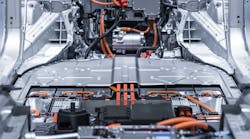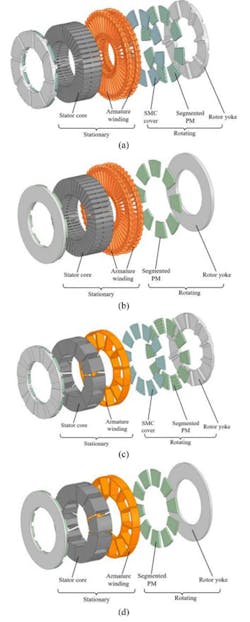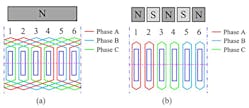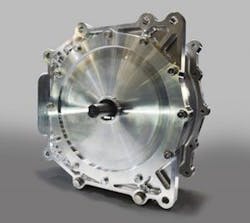This article is part of the Power Management Series: Delving Into Power Density
Members can download this article in PDF format.
What you'll learn:
- What is an axial-flux permanent-magnet motor?
- Types of AFPM motors.
- Benefits of in-wheel traction motors.
All motors can change their inherent energy into mechanical energy. The basic function of a motor is its coil and magnet, which are based on the principle of an electromagnetic interaction of the magnetic field generated by the coil and magnet contained in the structure itself.
In this article, we will discuss the benefits of the axial-flux permanent-magnet (AFPM) motor that delivers excellent, high power density.
The AFPM Machine
The very first motor, invented by Michael Faraday in 1821, was an axial-flux design. Later, in 1834, Davenport invented the radial-flux motor, which was known as the simple motor. Let’s compare these two types of motors.
The axial-flux motor has an air gap that’s planar. Because that air-gap magnetic-field distribution is along the axial direction, the air-gap magnetic field is essentially perpendicular to the air-gap plane. In today’s motor development, the trend is high speed, low weight, and high efficiency—all traits of the axial-flux motor.
The advantages of these motors are:
- High power density
- High torque density
- Small volume
- Low weight
- Compact structure, in particular for short axial sizes
- Small end-winding
- Very good cooling performance
Axial-Flux Motor Applications
High power density does not only depend on high speed, but also on the influence of torque density. High speed leads to short service time and higher noise; however, the core of the high-speed motor is the enhancement of torque density. The axial flux motor brings these benefits to such applications as motor bikes, aircraft, and automotive (including racing vehicles).
Types of AFPM Motors
One main use of the AFPM motors is for electric-vehicle (EV) in-wheel traction applications. AFPM motors need to meet two main requirements for this application: high power density and fault tolerance. The following are some types of AFPMs:
Yokeless Stator AFPM with FSCW
AFPM motors that have a fractional slot concentrated winding (FSCW), with a yokeless and segmented armature (YASA), have recently been a choice of designers for their high-power density and potential manufacturability. That’s due to their concentrated winding and modular stator core configuration.
One problem with FSCW machines is significant rotor loss caused by armature reaction harmonics, which can present challenges with rotor heat dissipation. This is especially evident in high-speed usage for EV traction applications.
Another Option
Using distributed winding is commonly employed in high-speed radial-flux permanent-magnet (PM) motors. This option enables low armature harmonics, thus helping to improve rotor heat dissipation.
AFPM Windings
A comparative study was done for yokeless stator AFPM traction motors with integer-slot distributed-winding (ISDW) and FSCW configurations in EV applications.1 Let’s take a look at an optimal combination of stator and rotor configurations that are among four feasible topologies (Fig. 1).
The ISDW configuration, a 48-slot 8-pole structure with double layer, is one of the most commonly used configurations for EV traction in vehicles such as the Toyota Prius. For the FSCW configuration, a 12-slot 10-pole structure with double-layer is considered a good choice among various options for a more sinusoidal back-EMF, high winding factor, and lower torque ripple (Fig. 2).
In-Wheel Traction Motors
The benefits of in-wheel traction motors (Fig. 3) are higher efficiency due to driving the wheels directly and bypassing the need for conventional power-transmission mechanisms. This method of high power and torque density along with lightweight properties also will enable lighter and more compact designs. Independent control of the wheels will lead to the possibility of further improving electronic stability control (ESC) and traction control systems (TCS) (Fig. 3).
Summary
Permanent-magnet synchronous motors (PMSM), powered sinusoidally, enable the special features required for traction motors to be applied in EVs. Among these, AFPM synchronous motors are an excellent fit for in-wheel applications. Electric motors used in this kind of application must meet two main requirements: high power density and fault tolerance.
Read more articles in the Power Management Series: Delving Into Power Density
References
1. Comparative Study of Yokeless Stator Axial-Flux PM Machines Having Fractional Slot Concentrated and Integral Slot Distributed Windings for Electric Vehicle Traction Applications, IEEE TRANSACTIONS ON INDUSTRIAL ELECTRONICS, VOL. 70, NO. 1, JANUARY 2023
2. Optimal Design of a Three-Phase AFPM for In-Wheel Electrical Traction, IEEE 2014
3. In-Wheel Motor for Electric Vehicles, Advanced Science News, Martin Grolms, 2019



